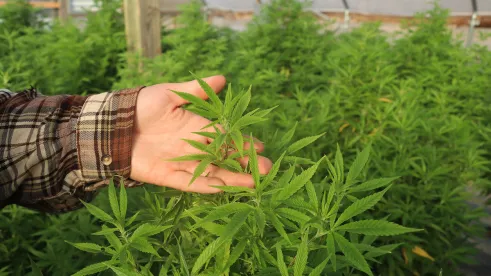The second year of the industrial hemp pilot program in Wisconsin saw immense growth in the number of licensed growers and processors statewide. Recently, the Wisconsin Department of Agriculture, Trade and Consumer Protection (DATCP) announced its intent to proceed under the pilot program for the 2020 growing season. Registrations and license applications are now being accepted.
DATCP’s announcement coincides with the interim final rule published by the U.S. Department of Agriculture (USDA) that will eventually set the regulatory framework for hemp production nationwide.
2019 Wisconsin growing season recap and 2020 applications
In 2019, 1,247 growers and 556 processors were licensed and registered to conduct hemp-related operations in Wisconsin. In total, 850 growers reported planting approximately 5,000 acres of hemp throughout the state.
As with the first year of the program, a significant percentage of hemp crop was ultimately destroyed for crossing the permissible THC threshold. According to DATCP, approximately 2,200 hemp samples were collected, but approximately 289 samples, or 13 percent, were ineligible for commerce certificates and ultimately destroyed. In many cases, destroyed crops were grown from seeds certified by the DATCP. This serves as a reminder that, despite its legal status, hemp remains a heavily regulated crop.
DATCP has indicated it will proceed under the pilot program for the 2020 growing season. This allows the state time to develop and submit its hemp regulatory plan to the USDA for approval.
The application window for new hemp grower and processor licenses and registrations is from Nov. 1, 2019, through March 1, 2020. Existing licensees intending to continue in the Wisconsin hemp pilot program are required to renew their registrations with DATCP during this window.
USDA interim rule suggests strict standards, limited flexibility for state plans
The 2018 Farm Bill allows states to adopt their own regulatory plans governing hemp production, subject to approval by the USDA. Last week, the USDA unveiled new rules detailing what the federal agency expects to see in state plans governing the production of hemp.
The USDA is accepting public comment on the proposed rules for 60 days before issuing final rules. While these rules won’t go into effect in Wisconsin until the 2021 growing season, the interim final rule offers growers an idea of what to expect in the future. In several respects, the final rules may be stricter than what currently exists under the Wisconsin pilot program.
The following are highlights from the interim rule:
Sampling and testing guidelines
-
The USDA published guidelines for sampling hemp grown in greenhouses and fields as well as testing to determine THC content. The department has also stated that testing must occur through Drug Enforcement Agency (DEA) registered facilities.
-
The USDA is considering requiring a hemp laboratory approval process or accreditation requirements for labs offering THC testing services.
Destruction of non-compliant plants
-
The rules acknowledge that cannabis crops that exceed the THC threshold will likely result in the loss of the economic value of the investment. The rules require the use of a “measurement of uncertainty” to be used when determining whether there is an acceptable hemp THC level.
-
Hemp crops that exceed the THC level may not be further handled, processed or enter the stream of commerce. The crops must also be destroyed consistent with DEA regulations. In this respect, the rules require stricter disposal regulations than under the current pilot program.
Multiple negligent violations may result in program ineligibility
-
The rules propose a narrower “safe harbor” provision for hemp with excessive THC content than exists state law. A hemp crop testing between .3 and .5 percent THC would not be considered a negligent violation if the grower uses reasonable efforts such as using certified seed or following other best practices.
-
If a grower uses these reasonable efforts, yet THC levels rise above 0.5 percent THC, the grower will be found to have negligently violated the USDA rules. Although negligent violations are not subject to criminal enforcement action, the consequences for multiple negligent violations are severe. A producer would be placed on a two-year corrective action plan. A producer who negligently violates a state plan three times in a five-year period would be ineligible to produce hemp for a period of five years from the date of the third violation.
USDA Farm Service Agency reporting
-
Even in states that develop their own regulatory plan, growers would be required to register with the USDA Farm Service Agency and provide the agency with information regarding hemp production under the state plan.
What’s next?
It is possible that the USDA will modify the final rules in response to public comment. Additionally, DATCP will begin developing its regulatory plan for approval by the USDA, which will likely take effect for the 2021 growing season. The hemp industry is also eagerly awaiting clarity from the U.S. Food and Drug Administration (FDA) on the approved uses of CBD.



 />i
/>i

